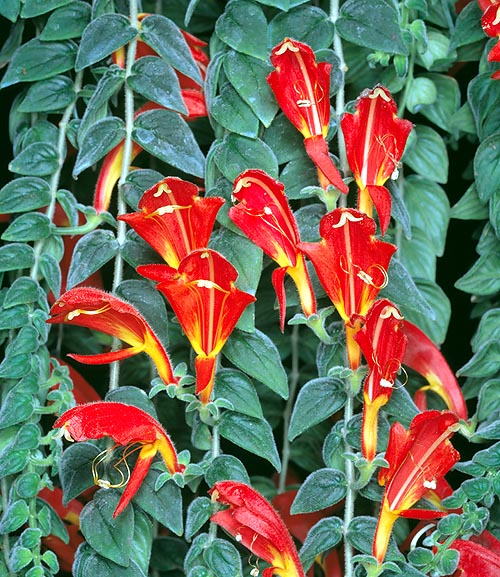Family : Gesneriaceae

Text © Pietro Puccio

English translation by Mario Beltramini

Columnea microcalyx is a Costa Rican creeping or drooping epiphyte © Giuseppe Mazza
The genus is honoured to the Italian naturalist, Fabio Colonna (Naples, 1567-1640); the name of the species is the combination of the Greek words “mikrόs” = small, and “kalyx” = chalice, with obvious reference.
Common names: goldfish plant, orange columnea (English); columnea glorieuse (French); columéia (Portuguese Brazil); carpa dorada (Spanish); Kolumnee (German).
The Columnea microcalyx Hanst. (1866) is a perennial, epiphytic, herbaceous plant
with thin creeping or drooping, 90 cm, and even more, long stems.
The leaves, on a short petiole, are opposite, tomentose, lanceolate or ovate lanceolate with sharp apex, 1,5-2,5 cm long, with green to reddish brown colour.
The flowers are axillary, solitary, tubular and curved, about 7 cm long, with an externally tomentose and orange red, corolla and yellow throat; the pollination is done by the hummingbirds.
The fruits are globular berries of about 1 cm of diameter, containing several tiny seeds. It reproduces by seed and by cutting in spring, utilizing 10-15 cm long portions of branch, on a sandy substratum, or rich of agri perlite, at a temperature of 20-24° C in a location with high atmospheric humidity or, failing this, enclosing the pot in a plastic bag in order to maintain the humidity.
Plant with a showy and long lasting flowering, to be cultivated as epiphyte on the trees or in hanging pots in luminous position, but never at the direct sun, and sheltered from the winds, in the tropical and humid subtropical zones, as it does not tolerate temperatures close to the 0 °C.
It needs a much draining, acidic, substratum, which may be formed by coarse peat with 30% of siliceous sand of agri perlite. The watering must be regular during the vegetative period, but without stagnations which may aver harmful; frequent nebulisations with not calcareous water and at ambient temperature, especially in the warmest periods if the atmosphere is too dry. During the resting period, the watering are to be reduced in order to allow the first layers of soil to dry up before watering again. This stimulates the flowering.
Where the climate does not allow the permanent cultivation in open air, it is to be sheltered in luminous ambient at a temperature not lower than 16° C, even if it may bear some degree less for a short time; the ambient humidity must be high, if low, in addition to the nebulisations, as already said, the pot may be placed on a wide saucer full of expanded clay or gravel with a layer of water, without any direct contact with the bottom of the pot; the sudden variations of temperature and the drafts are to avoided.
The pruning is to be done by early spring or just after the flowering. It is convenient to shorten the too long branches for stimulating the tillering and also for containing its posture; the repotting is to be done in spring when the substratum becomes compact, indicatively, every 2-3 years.
Synonyms: Columnea gloriosa Sprague (1911); Columnea tuerckheimii Sprague (1912); Columnea lutea Donn.Sm. (1914); Columnea localis C.V.Morton (1938).
→ To appreciate the biodiversity within the GESNERIACEAE family please click here.
